Climbing the States’ Tallest Bolted Moderates in Washington
This article originally appeared on Climbing
Fog fills the valley below. I'm freezing. We'd been told it's not uncommon to see 12 cars parked for Flyboys, an 18-pitch 5.9 sport climb on the Goat Wall in Mazama, Washington. Today, we have the wall to ourselves. It's no longer raining, but the rock is soaked. As I start up pitch one, seconding my friend Cole Osborne's lead, my feet slip off the wet stone. I hold myself on jugs, reset, and continue toward a short face where Cole French-freed across smears. My chalkbag contains four hand warmers, and I give my digits a quick toasting before moving up toward the wet friction moves. The chalk disappears from my skin as soon as it hits the water. Before long I'm in the Pacific Northwest fog. I can't see how far the wall extends above or below. It's just me and the rock in a void. From the road, the wall looked to be a dark, monochromatic gray. Now up close, I see flecks of orange and green lichen among white, black, and gray crystals. I grab an edge of the funfetti rock and step up. We'll only succeed if we keep moving.
I've always fantasized about climbing something big, and would love--like most of us--to top out El Capitan. But I've focused on sport climbing the past few years, and I've also had a difficult time progressing into higher grades. However, I'm solid on moderates. With 18 bolted pitches, none harder than 5.9, Flyboys was a route where I could have a real adventure at my current level--and top out something big.
Completed by Bryan Burdo and Jerry Daniels in 2017, Flyboys is the tallest bolted 5.9 in the United States. It's what would be called a plaisir climb in the Alps--a long moderate with closely spaced bolts that is meant to be enjoyable. Just 16 quickdraws will get you to the top. The Cascades' unique, rugged topology lends itself to these massive routes--bolted lines up to seven pitches have even popped up in the trad bastion of Index--but Goat Wall is the only place with a concentration of them. The lines here have become popular, but are tall enough to support multiple parties.
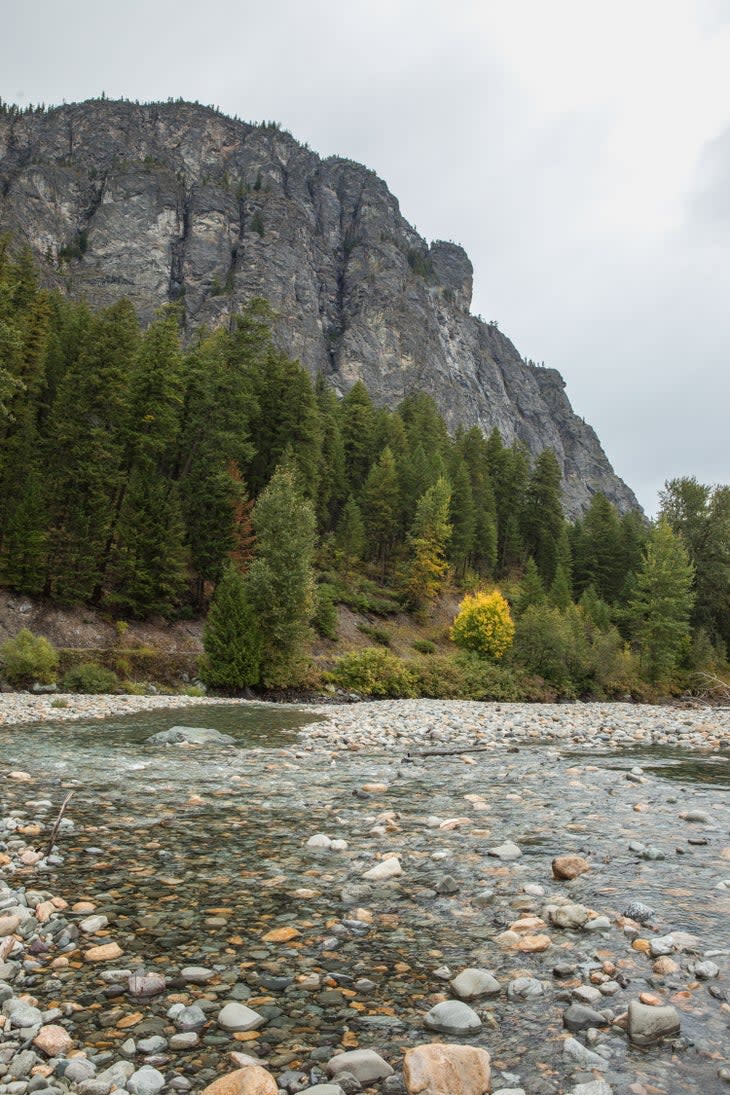
Joining me on the trip were Andrew Burr, Dakota Walz, and Cole. Andrew is Climbing's senior contributing photographer. Dakota is an EMT and author in Golden, Colorado, as well as a 5.13 trad climber who focuses on first ascents. He'd serve as Andrew's ropegun, fixing lines so Andrew could shoot. Cole, a paramedic who works with Dakota, would be my partner. I'd met Cole when he joined Dakota and I at the Fisher Towers. Dakota and I climbed Ancient Art, while Cole attempted to rope-solo Kingfisher. He bailed after aiding the first pitch of drooping, rusted bolts, but only seemed upset that he'd left his gummy bears in his pack on the ground. That was the kind of partner I wanted.
* * *
"It's pretty darn obvious," says Bryan Burdo when I ask how he discovered Goat Wall. "It's hard to miss something that obvious that's that close to the road." Goat Wall is a 2,000-foot-tall piece of glacially carved, meta-pyroclastic rock off Lost River Road in Mazama, deep in the heart of the North Cascades. Mazama is the gateway to Washington Pass and its granite alpine climbing. Fred Beckey, Jerry O'Neil, and Charles Welsh reached the summit of the iconic Liberty Bell as far back as 1946. But it wasn't until the late 1980s that Goat Wall received any attention. It also happens to be 1.5 miles wide and part of a greater 6-mile massif--it's impossible, as Burdo says, not to see it.
Cascade Loop Beta |
Index, Leavenworth, and Mazama are all located along Washington’s Cascades Loop scenic highway. This 440-mile byway is accessible within 30-minutes of Seattle and makes for an awesome climbing road trip. The Cascades Loop is home to all of the climbs featured in this article and more, including countless alpine routes, like the iconic Liberty Bell. Get more information here. |
Burdo, 63, summers in Mazama and winters in Seattle, and has made his living through construction, coaching runners, and writing guidebooks. He first visited the area with his family in 1971, and they owned several cabins there over the years. With a wall so expansive sitting in plain view, the question wasn't "How did you find it?" It was, "Why didn't anyone climb it sooner?" Burdo, who's been climbing since 1977, is the primary force behind Goat Wall and Mazama new-routing in general. CB Thomas, the owner of Goat's Beard Mountain Supplies, Mazama's gear shop, estimates that Burdo has put up 96 percent of the rock routes in the area. Burdo doesn't dispute this number, and a quick flip through the guide (which Burdo wrote) confirms it.
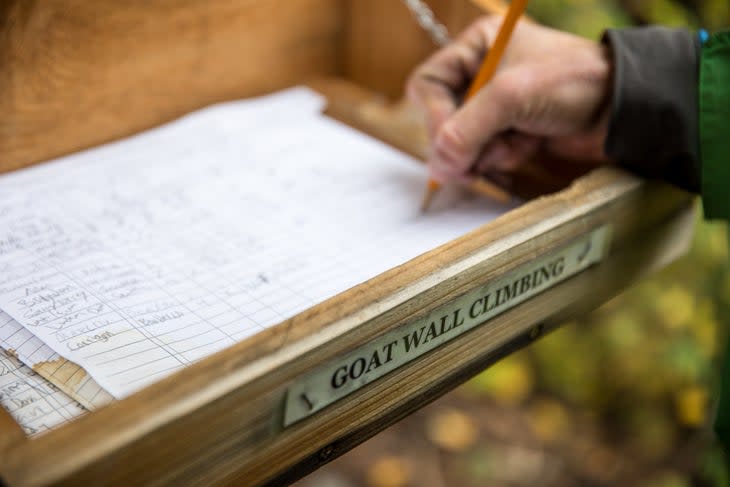
Burdo has been a prolific Washington developer for decades, with hundreds of FAs. He's largely responsible for the popular Seattle areas Exit 32 and Exit 38. He's put up alpine routes in the Cascades. Perhaps his proudest line is the 18-pitch Vanishing Point (VI 5.12b) on Mount Baring near Index, ascending a 1,300-foot overhanging prow on Dolomite Tower. Burdo started focusing on Mazama around 2000.
"When I first got into climbing, all anyone climbed in Washington was granite, so that meant that I'd have to drive from right past Goat Wall up to Washington Pass to climb--like a 30-minute commute," he says. "I was always like, 'It's too bad the rock's all crap up there [on Goat Wall] and it doesn't take gear.'" Indeed, Goat Wall lacks continuous cracks; the rock seems more like it's been heavily broken then smoothed over with concrete. The features are there to climb, but there aren't many gaps between them for pro.
Burdo's first foray onto the larger Goat Wall lines came in the late 1980s with Promised Land, a 12-pitch 5.11a/A1. Recalls Burdo, "I climbed the central buttress, which is mostly face climbing, and it was all ground-up, bolting on lead with runouts on questionable rock." The first three pitches have been retrobolted, but Burdo speculates that the full, original line hasn't had a second ascent. It wasn't until 2000 that the wall's first modern mega-moderate went up with Burdo and Scott Johnston's Prime Rib (5.9; 11 pitches).
* * *
Andrew, Dakota, and I landed at SEA-TAC in September--allegedly one of Washington's warmer, drier months--to a dismal forecast. Goat Wall was our main objective, but we'd planned to hit Index and Leavenworth along the way, tagging a few other bolted moderate, multi-pitch routes to warm up. We'd have to make the best of it.
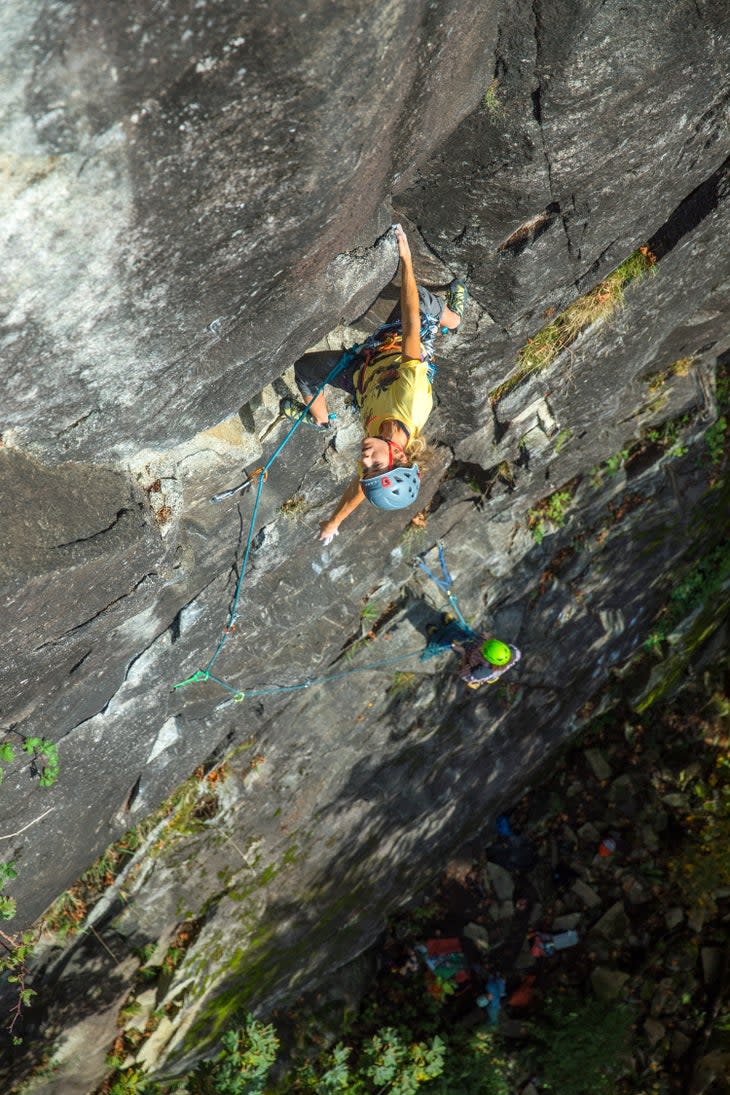
Our first two days in Index were soaked. At the Toxic-Tang Area, the routes may as well have been waterfalls. Jamming the opening parallel cracks of Toxic Shock (5.9), it felt like I was trying to plug holes in a dam as the water streamed down my arm and into my jacket.
On our first sunny day of the trip, we made the hike out to Lower Lump wall to climb our first bolted multi-pitch. Named for Pat Sullivan, an Index local who survived a 100-foot groundfall from the top of Thin Fingers (5.11a), Walking Legend (5.10c) follows three pitches of edgy face climbing that's uncharacteristic for Index. We'd selected the climb because it was the easiest option. After two days on Index granite, I understood why everyone talks about how difficult the place is. I opted for the one route I might be able to finish.
Video: Behind the Scenes of Long, Easy Routes
The first pitch was supposed to be the easiest, but for me the crux came on a traverse after the first bolt. The dense trees had sheltered the lower rock, and it was still soaked. I started up confidently, clipped, then stepped wide onto a small, sloping foothold, but only tentatively weighted it. Fuck that, I thought, imagining my foot flying off the edge. Instead, I climbed higher to a rail of underclings and sidepulls, only to be shut down by a wet nubbin. I started getting frustrated. This was the first pitch of the first route, and I was blowing it. I downclimbed to the ground and recomposed myself. My second time up, I willed myself to commit to the lower, sloping foot, and before I knew it was pulling on jugs to stand on a ledge. Just another bolt past that, the sun had burned the moisture away and I was moving up cruiser moves on dry stone. Suddenly, I was having fun.
* * *
"I had never [developed] a multi-pitch before," says Jerry Daniels. "I was kind of naive. Like, 'How much work could that be?'" Daniels, 56, moved to Mazama full-time in fall 2019 after splitting his time between Seattle, where he worked as an exercise therapist for patients with neurological disorders before retiring. He has been climbing for 20-plus years.
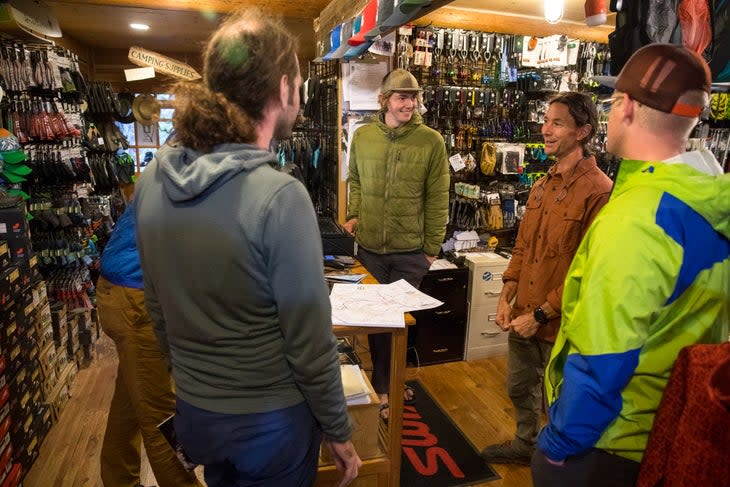
Daniels had approached Burdo because he'd wanted to learn to develop routes. Burdo was the guy, and Daniels wanted to learn to do things the right way. The pair started by developing some single-pitch routes. One day, Burdo asked Daniels, "I've got this four-pitch climb I'm working on--it's on the lowest tongue of Goat Wall. You wanna come up and have a look?"
That route, which would eventually expand past the lower pitches to become Flyboys, would take them two seasons to establish. The pair followed a two-days-on, one-day-off schedule, spending 8 to 10 hours on the wall at a time. Burdo estimates that he spent six to seven weeks of cumulative time working on Flyboys, with Daniels putting in four to five. Working top-down, the pair fixed ropes on the entire route and would stash bolts, chains, and crowbars at the top of pitches. In total, the pair drilled 275 bolts and spent thousands of dollars on gear. Funding came from a few sources--Daniels's wife, Annette, who worked in corporate sales and also climbs, was one of them.
"I'd be like, 'Honey, I need to order some more bolts, or I need to order scrub brushes, or we need rope'--a spool of rope here and there," Daniels says. The team also launched a GoFundMe campaign, raising $2,000 in just days. Burdo's reputation drove contributions. One thing they didn't expect was that half the donations would come from outside Washington--places like Florida, North Carolina, and New York. That's when they realized how much demand there was for the kind of route they were creating.

The last funding source came from Burdo selling the family cabin after his parents passed away. Burdo's father had been a pilot. He and friends would fly small planes from the grass airstrip amidst the cabin community where Burdo, Daniels, and Thomas now live. The route is named Flyboys in tribute to the airmen.
* * *
Andrew, Dakota, and I had been all-in on the Washington trip since day one, while Cole had agreed before receiving his semester's class schedule--and learning that he would fail out if he joined us for all 10 days. He committed to making it work by arriving at 2 a.m. on our third night. Dakota surmised that Cole would feel guilty about waking us when he entered our shared bunkhouse at the Sleeping Lady Resort in Leavenworth. To prevent this, Dakota devised a prank to ensure that Cole would wake us--and thus not need to feel guilty.
"What the fuck? ... What the fuck?"
I awoke to the sounds of Cole's confusion and the tower of beer bottles we'd stacked behind the door clattering to the floor. Then I spent hours staring at the bottom of the bunk above me, unable to fall back to sleep. The joke was on me.

The next morning, we'd climb Condorphamine Addiction (5.10b) in Icicle Creek Canyon near Leavenworth. The guidebook calls it seven pitches, but four pitches with a 70-meter rope makes the most sense. We started the day by losing the trail and then bushwhacking for 1:15 up dense brush, boulderfields, and loose slopes. The weather cycled between rain and sun as we hiked. On this day, the rock was dry when we reached it, and the rain provided a vibrant rainbow, framing views of the snowcapped Enchantments to the south. We moved up featured slabs and ladder-like vertical faces. The first crux pitch featured bolts every three feet inside a rounded stem-and-smear corner. Lulled into a false sense of security, I soon found myself panicking on the second crux, 10 feet above the last bolt on the hardest, least-secure moves of the route--friction smears and what can only be described as "psychological holds."
* * *
"I really enjoy unlikely-looking routes, where it'll look like a 5.12 and turn out to be a 5.10," Burdo says.
Burdo and Daniels scoped Flyboys from the road with binoculars before venturing up. One feature stood out to Burdo: a chimney near the middle of the wall. Daniels remembers when Burdo first rapped in to the feature, on what would become pitch 14.
"[Burdo] drops down and I can hear him say, 'Oh, my God, it's gonna go! I can't believe it--this is so rad!'" Daniels says.
Daniels descended second. He was petrified by the free-hanging rap 800 feet off the deck; he didn't even look at the pitch. He reached the ledge below before turning to the wall and telling Burdo there was no way it could be 5.9, to which Burdo responded with detailed, blow-by-blow beta.
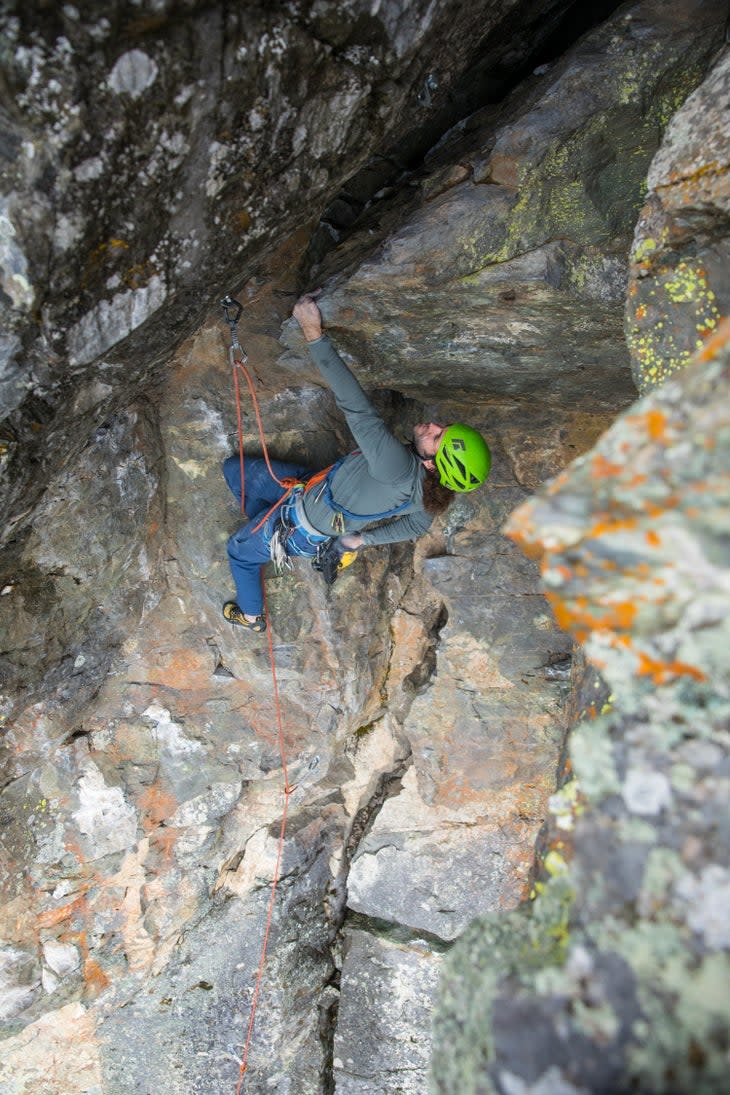
"I never believed it was 5.9 until we climbed it, which was months later," says Daniels.
The key to the 70-foot pitch is a chockstone flake. You move into a huge crack on face moves, pull the juggy flake like a roof--one of Flyboys's cruxes--then chimney up easier terrain to exit. The pair reinforced the chockstone with two pins that Daniels's neighbor, a non-climber, had picked up at a garage sale, not knowing what they were for.
"I was like, 'I can't believe we've got this huge flake right where we want it,'" Burdo says. "It was pretty amazing, almost like being able to manifest your hopes and dreams for that particular thing to happen."
* * *
The Methow Inspiration Route (5.9; five pitches) was our introduction to Goat Wall. It's one of the few routes not developed by Burdo, and it's apparent in the bolting. Where Flyboys has a bolt every six feet on average, Mountain Project warns new 5.9 leaders against the Inspiration Route due to the runouts--up to 30 feet in some spots, as we'd learn.
It started raining as I led the first pitch. It had been beautiful throughout our two-hour drive from Leavenworth. Now, menacing clouds swirled in the valley north of us. Typical. On pitch one I dealt with the worst of it: wet rock and runouts. I moved slowly and delicately through what would have been easy climbing on any other day. I tiptoed around an exposed corner while runout the length of a gym route, clipped a bolt, and then spent five minutes hesitating while perched on an airy ledge, pawing at holds too thin or slopey to use in the rain. The rock at Goat Wall is covered in edges, nubbins, divots, and pockets, like climbing a sheet of extra-large, elephant-gray bubble wrap. You always have options, but I didn't like any of them. Later, while following the (dry) crux pitch, I'd be thankful I'd led pitch one instead of risking the 20- to 30-foot falls between every bolt on the sustained, vertical face.
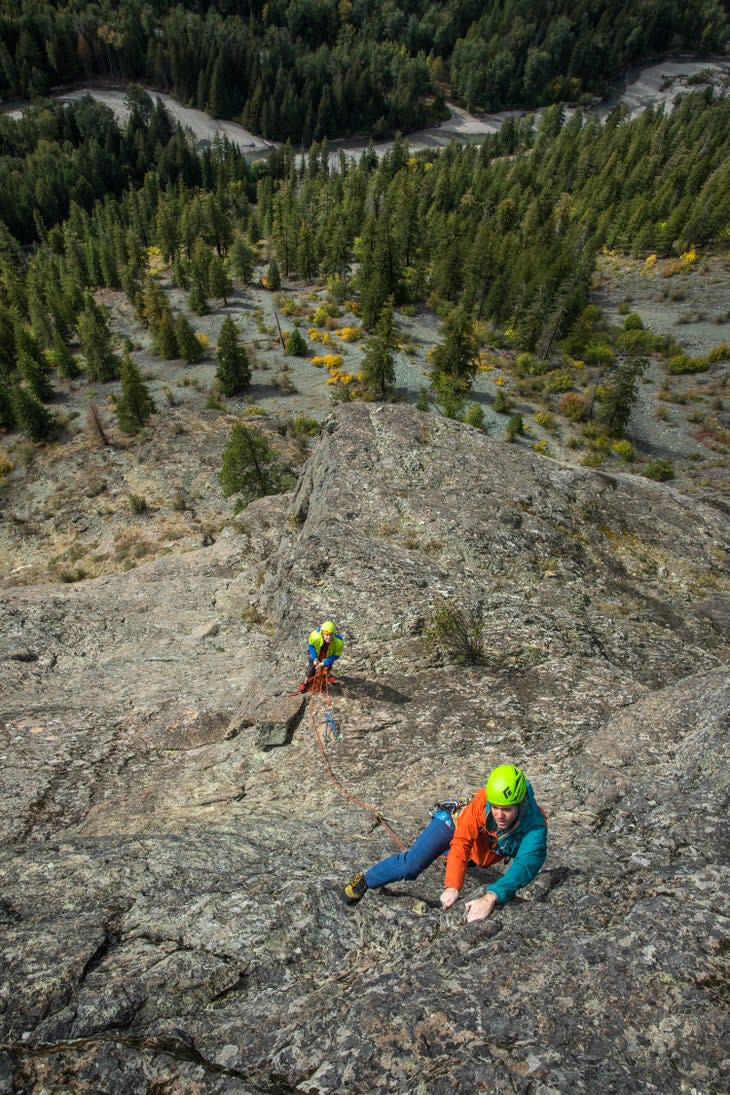
Three days later, we met up with Burdo and Daniels at the parking lot below Flyboys so Burr could shoot their portraits. He had asked them to bring props, something that illustrated their work as developers. He'd suggested drills. The team instead brought brushes and pry bars.
"The thing about the rock here in Mazama is that we get a lot of freeze-thaw cycles," says Daniels. "It tends to have a lot of loose rock. And a lot of lichen. So you use a lot of prybars, and as a general rule of thumb we always dropped in or climbed up and then cleaned from above. [On Flyboys,] we took blocks off anywhere from basketball to refrigerator size."
The pair divided the route into two sections: pitches 1-9 and 10-18. Flyboys angles right throughout, so one person would clean the upper half while another cleaned the lower half, with no danger to the lower developer. Still, the team had to be careful. The approach to Prime Rib nears the base of Flyboys. Burdo and Daniels would only trundle if the parking lot was empty, and whenever possible, if they had a clear view of the scree field below. They even fenced off the route base with caution tape, at times.
* * *
On the day of our Flyboys ascent, tubes of fog flowed up the valley below like lazy slugs. Snow covered the mountains above, stopping abruptly at a certain elevation, defined by a horizontal line across the range. When the rope came tight, I didn't hesitate. Three wasted minutes per pitch would add an hour to our day; we'd only finish if we were efficient.
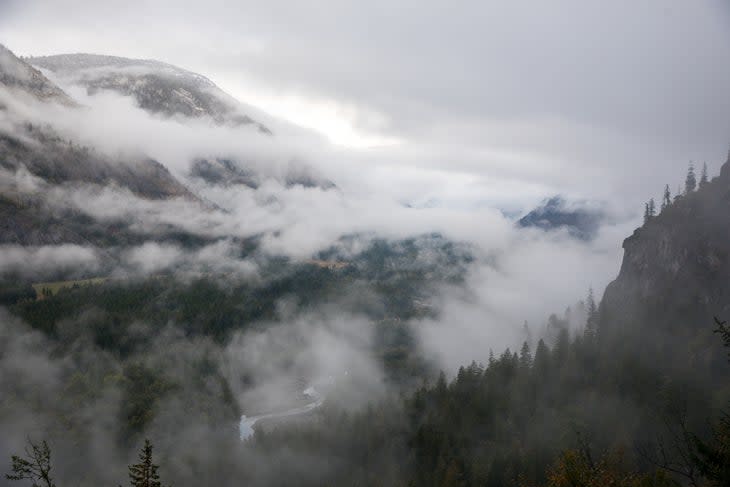
As we climbed higher, the rock dried. It never got warm, but it did get less cold. The pitches blurred together in a flurry of crimps and jugs. Every time a move felt hard, I'd look around and a better hold would materialize. At various points, I was so focused on moving quickly that I had to remind myself to have fun. I led pitch 14, Burdo's baby. I was intimidated moving up to the chockstone. After a high reach, I latched the flake's edge, an amazing jug, and wondered how I'd pull through. As the pump built, I swung my left heel around the side of the curving feature, pulled in with my leg, and I was done. Above, a short, easy chimney took us back into the sun. The pines had gotten just a little smaller down below, as they'd do with each pitch throughout the day, shrinking from a mighty forest to children's toys.
Flyboys does have its quirks. You'll need to pick up the rope and walk between most pitches. This made the climb feel more like 18 single-pitch routes than one continuous line. Burdo had told us before we started that we may wonder why there are bolts on flat ground. The intention was not necessarily to clip them, but to guide climbers across these sections. Burdo and Daniels also seemed to develop with an every-part-of-the-buffalo ethos. We skipped pitch 15, a section of bolted third class, because there was a trail alongside it.

We topped out at 4 p.m. The summit is anti-climactic, just a clifftop. We walked a snowy trail to a dirt road where we'd stashed mountain bikes, and then followed Goat Creek Road down for 13 miles, rarely having to turn our cranks.
* * *
It's clear that Daniels reveres Burdo, his friend and mentor, singing his praises at every opportunity, but Burdo makes it clear that the partnership goes both ways.
"There was no question in my mind 20 years ago that this area would be ... a national destination, but I knew how much work it would take," Burdo says. "I thought that at some point that there'd be someone else as maniacal as I was ... If it wasn't for Jerry, Flyboys would still be one of my many unfinished projects."
Both men are proud of their achievement, and delight in seeing others enjoy their work, but the increased traffic has brought growing pains. On one hand, local shops are seeing increased business. On the other, the area is beginning to have problems with human waste and trash.

"It's like, 'Careful what you wish for,'" says Daniels. "Mazama is this wonderful place that's nice and quiet and has really great climbing, and it doesn't have the overcrowding that a lot of areas have ... Hopefully it doesn't get that way."
* * *
On our last day of the trip, we were rewarded with beautiful weather. We spent the day climbing Prime Rib. The route is seven pitches shorter than Flyboys and 5.9- compared to the latter's 5.9. We climbed it casually over five and a half hours, taking time to joke at belays and marvel at the Methow Valley below and the Cascade Mountains to the north and west. I grabbed jug after jug, toed in on a never-ending supply of edges, and jammed the occasional crack. This constant flow of our team up the stone felt both casual and heroic--what I'd pictured it would be like before leaving Colorado.
Prime Rib and Flyboys follow adjacent ribs up Goat Wall, so the character of the line was similar: a stack of single-pitch routes, walking across ledges from pitch to pitch. But Prime Rib was completed 18 years prior, and it was interesting to see how Burdo's tactics had evolved. On Prime Rib, the bolts were farther apart. We often had to check the topo to discern anchors from rap stations. I even found myself getting gripped leading pitch 8, which spaces the bolts 12 feet apart on a slab where the edges are never quite big enough to feel secure. Prime Rib was like a prototype to the masterpiece of Flyboys.
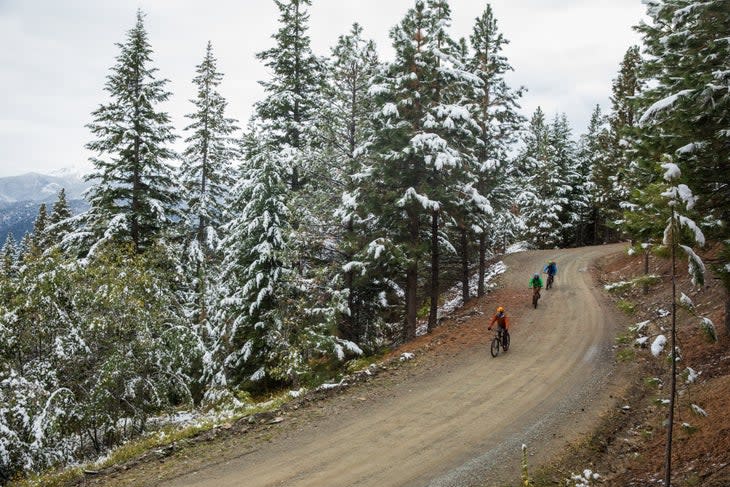
That night, we had dinner with Daniels, Burdo, and Annette. As he dug into a pile of ribs, Burdo told me that without kids or a house, he considers his routes to be his legacy. He told me of ambitious future Goat Wall projects. The wall is enormous, and mostly untapped, with potential for routes ranging from third class to 5.13 and heavy in the 5.10-5.11 range, given the varied verticality of the terrain. But one anecdote seemed to best sum up the routes we'd climbed.
Burdo said that back in his earlier climbing days, people didn't bolt routes to make them accessible. They put up first ascents for themselves and would use dangerous runouts "to keep the riff-raff out." He recalled a day when a woman approached him, beaming. She'd just led her first outdoor route--a moderate Burdo had bolted at Little Si--and wanted to thank him. "That was it," he says. Burdo still bolts projects for himself--he is prolific--but he changed his main focus to putting up routes for the masses: well-bolted moderates. Flyboys is that concept escalated to its logical end: the tallest, bolted 5.9 and the most accessible 1,800-foot route in the United States.
Find trip-planning info for all of these destinations and more at cascadeloop.com.
Multi-Pitch Tips
When climbing long routes, wasted minutes add up to hours throughout the day. To speed things up:
Belay from above with a Grigri. While a guide-mode tube-style device will do the job, a Grigri provides less friction when pulling in slack, which will spare you shoulder fatigue. (Note: Petzl doesn't necessarily recommend this practice--check their literature for more.)
Avoid downtime. Eat, drink, etc. while belaying your partner from above, and then rack any extra draws on the anchor so they're ready to go when your partner arrives.
You don't have to climb like you're in a race, but you should climb at a consistent pace. Hesitation saps time.
The Next Best Things
Flyboys is by far the tallest bolted 5.9 in the United States, but you don't have to travel to Washington to enjoy multi-pitch sport moderates. These four clip-ups climb 1,000 feet without crossing the 5.10 barrier.
Royal Flush (5.9; 1,500ft), Frisco, Colorado
Described on Mountain Project as "a 5.8 climb put up by a 5.13 climber for 5.8 leaders." (Though it's now considered 5.9.) A sub-10-minute approach leads to the long gneiss-granite route that ascends Mount Royal above the town of Frisco, right in the heart of scenic Summit County.
Memorial Route (5.8+; 1,000ft), Slick Rock, Idaho
Wear comfortable shoes for this huge granite slab. As one commenter said, "If this were in Colorado, it would get done all the time." Since it's in Idaho, it doesn't. Bring one pink Tricam to supplement your draws.
Void of Form (5.9; 1,000ft), Mount Lemmon, Arizona
As with Flyboys, climbers can enjoy comfortable belay ledges throughout this line to the top of Pontatoc Peak. Rap the route with a single 70-meter rope, or enjoy the scenic walk-off through Arizona's high desert.
Cosmic Space Dust Lasers (5.8; 1,000ft), Rock Canyon, Utah
This is perhaps more of an adventure route than the previous routes listed. Climbers report plenty of loose rock, but those who don't mind a little chossaneering will be rewarded with an incredible position.
For exclusive access to all of our fitness, gear, adventure, and travel stories, plus discounts on trips, events, and gear, sign up for Outside+ today.

